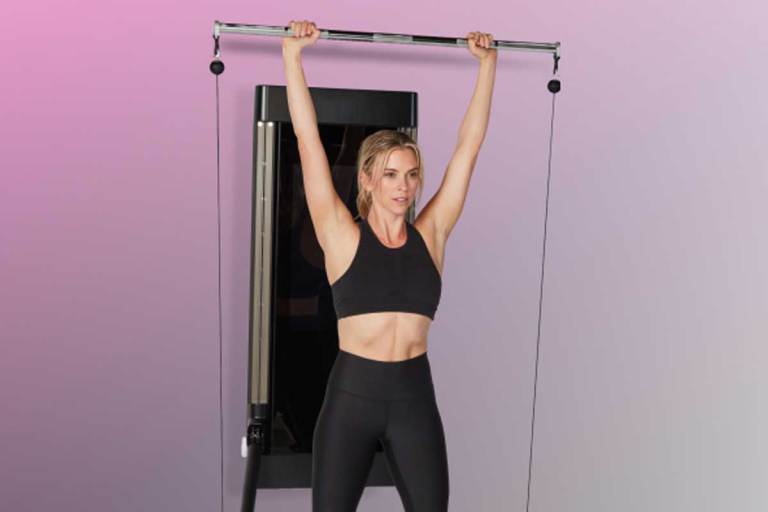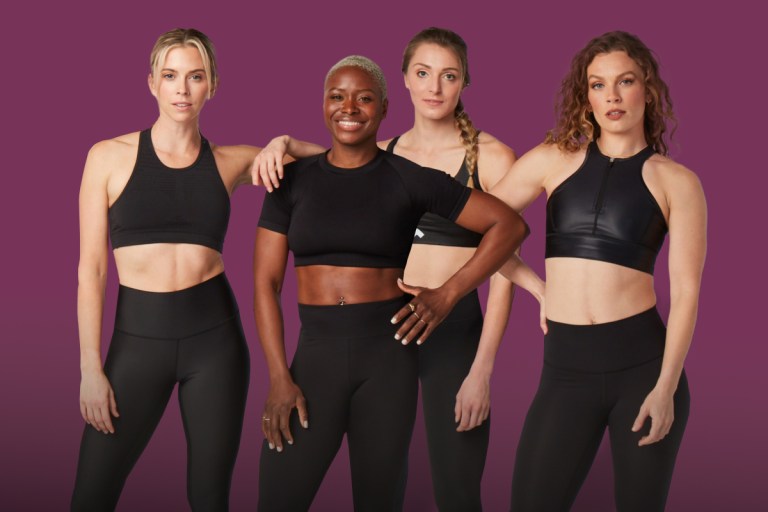How to Track Your Period to Optimize Your Training

Get the most out of your workouts by understanding your menstrual cycle and hormonal shifts.
Shifting levels of estrogen and progesterone hormones during your menstrual cycle affect training variables including muscle protein synthesis, strength and power development, and the ability to recover from hard efforts. Cycle Sync Strength is a new four-week training program designed in collaboration with female physiology expert Stacy Sims, PhD, that aligns your workouts with your cycle, so you can train more effectively and reach your goals faster. The program launches on Tonal on April 3, 2023.
Athletes who menstruate know that exercise can feel different depending on the phase of their cycles. As hormones fluctuate during the month, an easy workout might seem more challenging on one day, and on another day, you might be surprised by how strong and powerful you feel. When you learn how to track your period and harness the power of your cycle, though, you can actually use these shifts to boost your training.
Understanding your cycle and the changing hormone levels that come with it can unlock a new level of potential in your training. By tracking your cycle, you’ll understand which days you’re feeling more resilient and can push for big PRs and which days you should focus on recovery.
Ultimately, you can give your best performance at any point in your cycle, so there’s no need to panic if your big race or competition falls during a week when you typically train lighter or expect to have your period. Instead of letting your cycle dictate what you can or can’t do, use this information to empower you to work with your hormones—not against them.
Here, female physiology expert and Tonal Advisory Board member Stacy Sims, PhD, breaks down the different phases of the menstrual cycle, how to use your hormones to your advantage, and how to track your period.
How Your Menstrual Cycle Can Inform Your Training
During your menstrual cycle, your levels of the hormones estrogen and progesterone rise and fall, triggering ovulation (the release of an egg from an ovary) and the growth and shedding of the uterine lining. A typical menstrual cycle lasts 28 days (although yours may be longer or shorter), and breaks down into the following phases:
Week One: Menstruation/Early-Follicular Phase
Starting on the first day of your period, the follicular phase is typically the longest phase of your cycle. It’s also when the most variation occurs, so if your cycle isn’t exactly 28 days, it’s likely because of a longer or shorter follicular phase. During this time, your estrogen and progesterone levels are the lowest they’ll be all month, making you more resilient and primed to take on the stress of hard training. It’s a good time to lift heavy, sprint, or do high-intensity workouts.
“From a physiological standpoint, when those hormones are low, we are able to really hit high intensities,” says Sims. “We have more carbohydrates available for hitting those high intensities, and we have more water available for sweating so we have better thermal regulation.”
Sims explains that pushing yourself during the first few days of your period may actually help ease menstrual symptoms, too. “A little bit of high intensity actually feeds forward into giving a boost of anti-inflammatory and anti-oxidative responses, which then helps to reduce cramping and pain,” she says.
Week Two: Mid-Follicular Phase
The follicular phase continues as estrogen and progesterone levels are still relatively low, so you can continue hitting hard workouts and going for strength and power PRs. Toward the end of this phase, though, estrogen levels begin to rise in preparation for ovulation. Because estrogen on its own is anabolic and promotes muscle building, take this opportunity to push hard in your workouts, Sims says.
Ovulation
Typically occurring around day 14 of your cycle, ovulation is marked by the release of an egg from your ovary. Signs of ovulation include a slight rise in body temperature and increased discharge. Estrogen spikes right before ovulation and progesterone starts increasing so Sims advises completing your more difficult workouts 24 to 48 hours before ovulation, as rising hormone levels make it harder to recover from challenging efforts.
Week Three: Early-Luteal Phase
Rising levels of estrogen and progesterone following ovulation may leave you feeling less resilient to stress, more prone to inflammation, and less explosive than you were the previous two weeks.
“Estrogen and progesterone together inhibit the body’s ability to access carbohydrates, so it becomes harder to do those top intensities,” says Sims. “We also know that progesterone is catabolic, so it breaks down lean mass.”
You’re still capable of training hard, but if you want to take advantage of your unique strengths during this phase of your cycle, focus on steady-state aerobic work as your body is more efficient at burning fat as fuel.
Week Four: Mid-Luteal Phase
If you suffer from symptoms of PMS including bloating, cramping, or fatigue, they’ll start to pop up in the week leading up to menstruation as estrogen and progesterone levels peak and then start to fall.
“It’s very individual as to when these hormones start to drop, but as they start to drop, we have a significant shift in increased inflammation and an increase in our baseline cortisol,” says Sims. “From that physiological perspective, this is the point where your body is least resilient to stress so we look to deload.”
Now’s the time to focus on recovery and mobility. You’ll prime your body so it’s ready to work hard again next week when hormone levels are low and the cycle begins again.
How to Track Your Period
Tracking your cycle can be as simple as noting down the first day of your period on a calendar each month. Eventually, you’ll be able to gauge your typical cycle length and predict when your next period will begin.
For a more detailed understanding of your cycle and the length of your follicular phase, take your temperature each day, as body temperature can indicate when you’re ovulating. According to Sims, the estrogen surge right before ovulation lowers your temperature slightly. After ovulation, rising progesterone levels cause an increase in temperature.
“Once you see that upsurge in temperature, you know you’re in the luteal phase. When you see a dip and then a rise, you know you’re around ovulation,” she writes.
There are also apps available for logging your cycle. Once you log your period a few times, some apps will start telling you what phase you’re in and predicting your next period, taking the guesswork out of tracking.
You can also log additional information such as your daily mood, energy level, or any symptoms including cramping or fatigue. Over time, you might see patterns appear. For example, you may feel more tired than usual on the days leading up to your period or feel a surge in energy the week after you finish menstruating. Use these data points to inform your training, scheduling more demanding workouts on the days you typically feel your best.
If you use oral contraceptives, it’s still worth tracking your energy, mood, and symptoms to understand changes in your body during each week of your pill pack. If you have a non-hormonal copper IUD, you’ll still experience ovulation and can use the same method for tracking natural cycles. With progestin-only IUDs, Sims notes that ovulation typically resumes about eight months after insertion.
Just like dialing in your nutrition and getting plenty of sleep, tracking your cycle is another strategy for getting the most out of your training. Just remember that you can perform your best at any point, but when you learn to work with your cycles, your period can become a superpower for you.
- FITNESS



